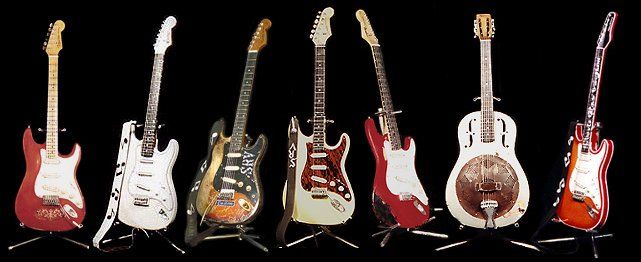
On this page are details of Stevie's collection of guitars. The well known ones are at the start and further down the page there are the lesser known guitars, or ones that had been used maybe only once or twice, or even had been lent to Stevie.
In addition, there were a few other guitars that Stevie owned which were included on a 1988 appraisal and valuation by Ray Hennig of the Heart of Texas Music store, in Austin, TX. The full list can be seen at the bottom of this page.
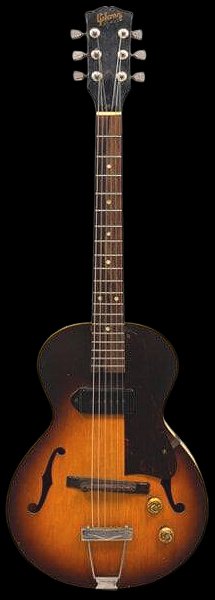
This is Stevie's childhood guitar, a 1957 Gibson ES-125T 3/4 Sunburst Archtop Electric Guitar, Serial no U142221.
It has 22 frets, two F-holes, volume and tone controls and a raised pickguard.
It was a well used guitar, as Stevie spent his formative years practising on it. This caused various nicks, scratches and general wear on it.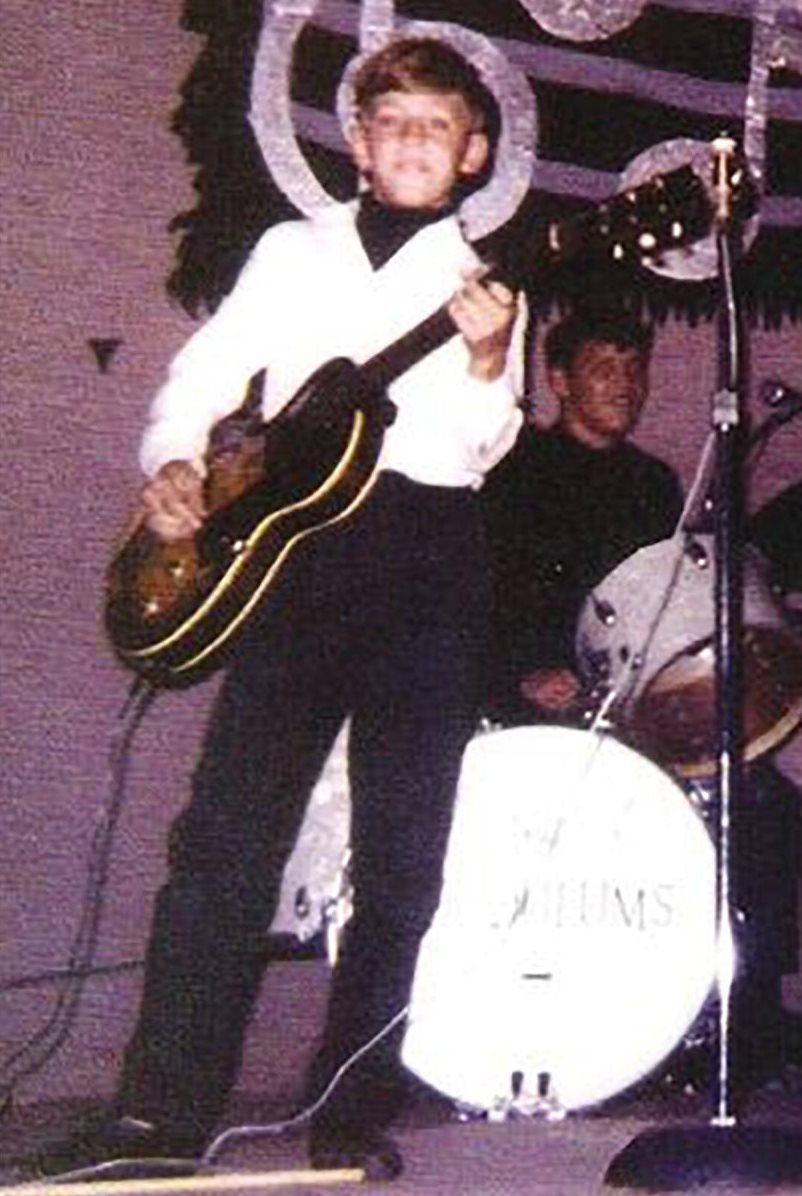
1951 Fender Broadcaster - handed down to Stevie from Jimmie. Stevie practiced and performed a little with this guitar around 1966. (see also below)
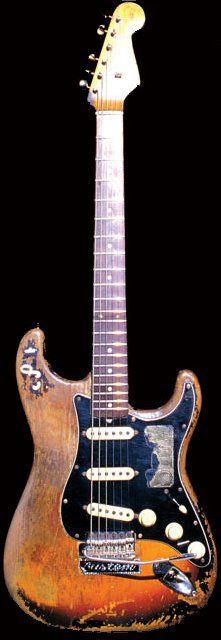
This was Stevie’s main guitar. He got it from the owner of Ray Henning’s Heart of Texas music shop in 1973, and it quickly became his main companion. Number One originally had a white pickguard which was replaced with a black one that now adds the “SRV” logo, and a right-handed tremolo bar – now gold-plated left-handed.
The guitar was built using a 1963 Stratocaster body and a 1962 neck, even though Stevie believed it was a 1959 Stratocaster. It is rumoured, although not proved, that he believed it was a 1959 model because he once took the pickups off and realized that they were made in 1959, so he made a conclusion from that. It was not until 1980 that Rene Martinez took the whole guitar apart and saw the year 1963 stamped in the body and 1962 on the neck.
Stevie’s Number One is finished in sunburst and it’s original neck has a thick, D-shaped profile with 1-5/8″ (41mm) nut width. The fingerboard radius was originally 7.25″ but eventually came down to 10″. This was a consequence of countless refret jobs done by Rene Martinez, who mostly used Dunlop 6100 fretwire. The headstock was fitted Fender Schaller Elite Gold tuner pegs.
The neck eventually became damaged beyond repair, so Rene figured out he’d put the neck from Stevie’s 1962 red Stratocaster on it. Unfortunately that neck was broken into pieces at a show in Holmdell, New Jersey, when a piece of stage equipment fell on several of Stevie’s guitars. After that, Number One had a new Fender neck until after Stevie died, when the original Number One neck was re-installed on it.
Number One is currently in the possession of Jimmy Vaughan.
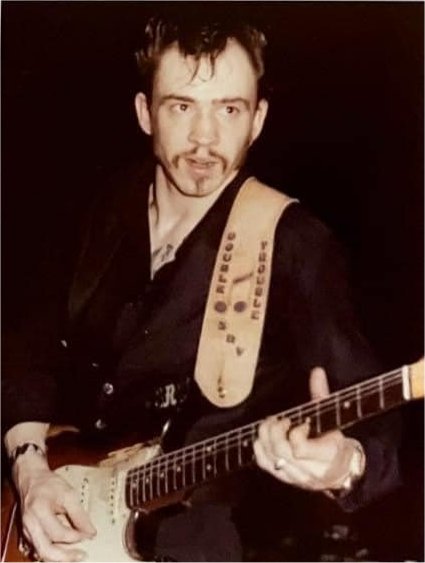
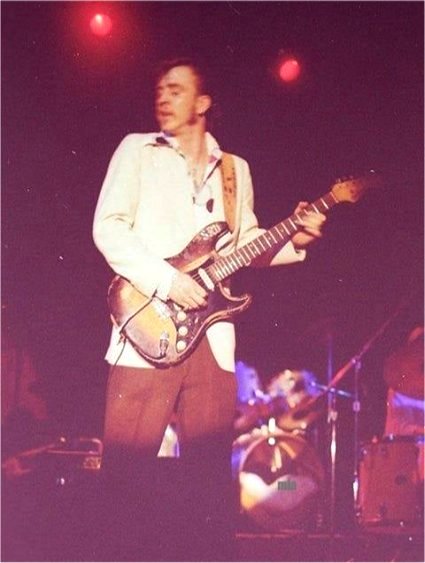

This guitar first caught Stevie’s attention around 1979, when he went with couple of friends to a pawnshop in Austin, Texas.
Unfortunately it cost $350, and he couldn’t afford it at that time. That didn’t stop his wife, Lenora, who talked to a couple of Stevie’s friends to cash in $50 each, so they could give it to him as a birthday present. The plan worked out, and they presented the guitar to Stevie on October 3rd 1980 at Steamboat Springs – nightclub he often played at.
The guitar was originally a 3-tone sunburst maple-neck model with a rosewood fingerboard. It was refinished by the previous owner with a dark natural color, and it had arty inlay behind the bridge.
Stevie decided to replace the neck with the mid-’50s-style maple neck given to him by Billy Gibbons. He kept the tremolo arm, pickups and frets in their original condition, but added his signature and initials on the neck plate and pickguard.
This guitar also has Mickey Mantle’s autograph on the back of the body, who signed it on April 10, 1985, when Stevie was invited to play the national anthem at the Houston Astros season opener at the Houston Astrodome.
Stevie recorded with this guitar on many of his heartfelt love songs, including “Riviera Paradise”, and of course – “Lenny”.
The guitar was put up for auction at the Eric Clapton Crossroads Guitar Festival on June 24, 2004 and it was sold to Guitar Center for $623,500.

This guitar was previously owned by Vince Martell, Vanilla Fudge’s lead guitarist, who sold it to Charley Wirz of Charley’s Guitar Shop in Dallas.
The previous owner had hollowed out the body to mount four humbuckers but Wirz removed those and installed a new pickguard in which he placed a Fender single-coil pickup in the neck position. He also painted the whole body yellow, and installed Charvel brass tremolo system.
Charley then gave the guitar to Stevie in early 1981, who added SRV decals where the two pickups would normally be placed, just under the strings.
This was supposedly the guitar Stevie played on the album versions of “Honey Bee” and “Tell Me”, and live on DVD “Live at Montreux” for the last song on the set – “Collins Shuffle”.
Yellow was stolen in 1985 at the Albany International Airport in New York, and has never been recovered. Some sources state that the guitar was later recovered and is now on display in the Las Vegas Hard Rock Cafe, but this is incorrect.
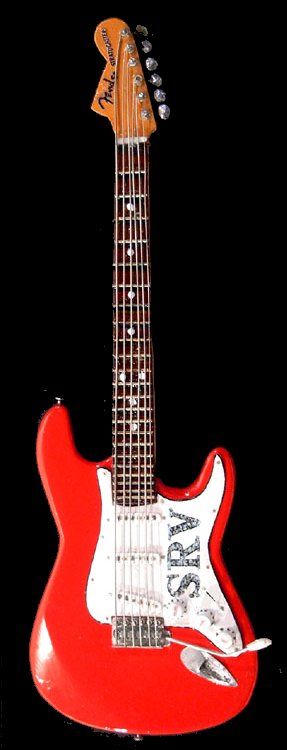
In late 1983, Vaughan purchased a 1962 sunburst Fender Stratocaster from Charley's Guitar Shop, though he had it repainted by Fender in fiesta red as a custom color option, and simply named the guitar "Red."
The guitar remained stock until December 1985, when a left-handed neck was installed and "SRV" stickers were applied to the pickguard.
In 1989, the neck on "Number One" was unable to withstand more re-fret jobs, replacing it with the original neck from "Red."
The next year, following a concert at the Garden State Arts Center in Holmdel, New Jersey, a stanchion fell onto Vaughan's rack of guitars, splitting the neck from "Red" that was installed on "Number One."
The neck was replaced in time for the next night's gig.

This was a custom Stratocaster-style guitar made for Stevie by James Hamilton in Buffalo, NY. It was presented to Vaughan by James as a gift from Billy Gibbons on April 29, 1984.
This guitar features a 2-piece maple body and a 3-piece "neck-through body" design. It also originally had EMG preamped pickups, but Stevie didn't like the pickups in it.
His next music video was about to be made, which was "Couldn't Stand the Weather" and he didn't want to get Number One wet during filming, so he used the Hamiltone for filming.
During the recording of this video the pickups were damaged, and soon after replaced with vintage Fender single-coils.
The EMG pickups and Gibson style amber top hat knobs were changed in June 1984.
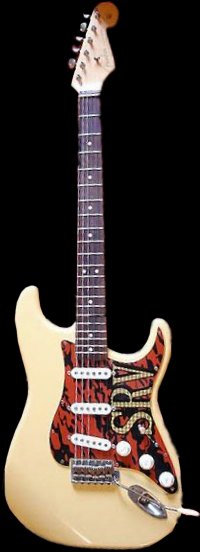
Scotch is a 1961 Fender Stratocaster used by Vaughan for the last 5 years of his life. He acquired this guitar in the fall of 1985, and it is said to have been bought in either Baltimore or "The Boathouse" in Norfolk, Virginia.
It was to be a prize at one of Stevie's shows, but he liked the guitar so much, he gave away another one of his guitars.
This guitar has a butterscotch colored finish and originally had a plain white pick guard, which was later replaced with a non-original tiger-striped pickguard made by Rene Martinez, Vaughan's guitar tech.
The guitar was stock except for the tiger-striped pickguard which resembled the same pickguard Buddy Guy had on his butter-colored guitar at the time.
The guitar, with the original pickguard can be seen on the front of the Live Alive album cover.
Stevie used this guitar when having problems with Number One, or regardless from that – live for songs such as “Leave My Girl Alone” and “Superstition”.
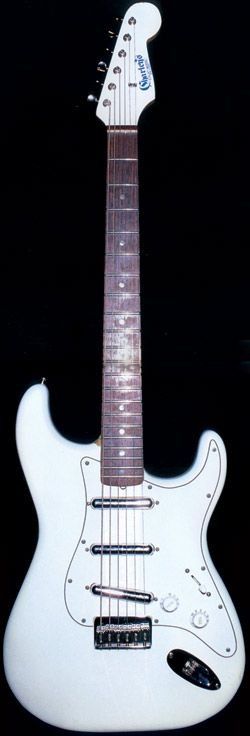
This guitar was made by Charley Wirz – owner of Charley’s Guitar Shop in Dallas, in 1984. It has a white strat-style body with a rosewood neck, two controls (volume and tone) and Danelectro lipstick pickups.
On the back of the body is a hula girl sticker and the neckplate has the words “To Stevie Ray Vaughan, more in ’84” engraved on it.
Stevie played this guitar on “Life Without You” (which was Stevie’s tribute to Charley after his death in 1985), and live on the “Live at Montreaux” video.
In 2003, Charley’s and Rene Martinez made 23 limited edition replicas of this guitar, selling for $2500.
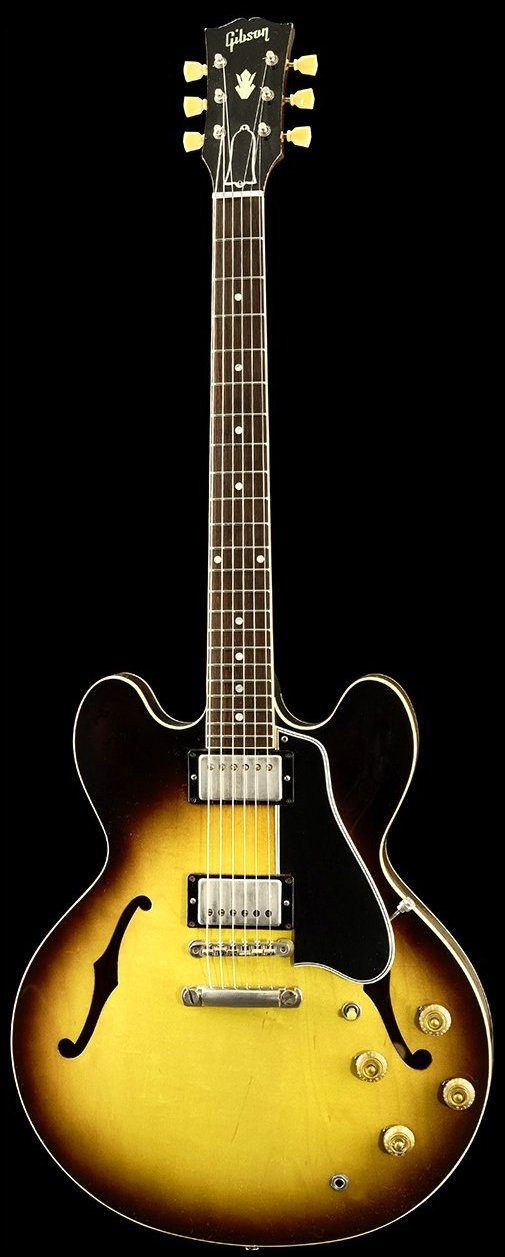
Stevie carried this guitar on tours between 1982 and 1985. It was given to him by the owners of the Continental Club; Roddy Howard, Roger "One Knite" Collins and Rick Warren, as an expression of their appreciation for Stevie's performances at their club.
The guitar is from 1958, and had a green finish on the inside, and was supposedly one of 500 that had that interior finish.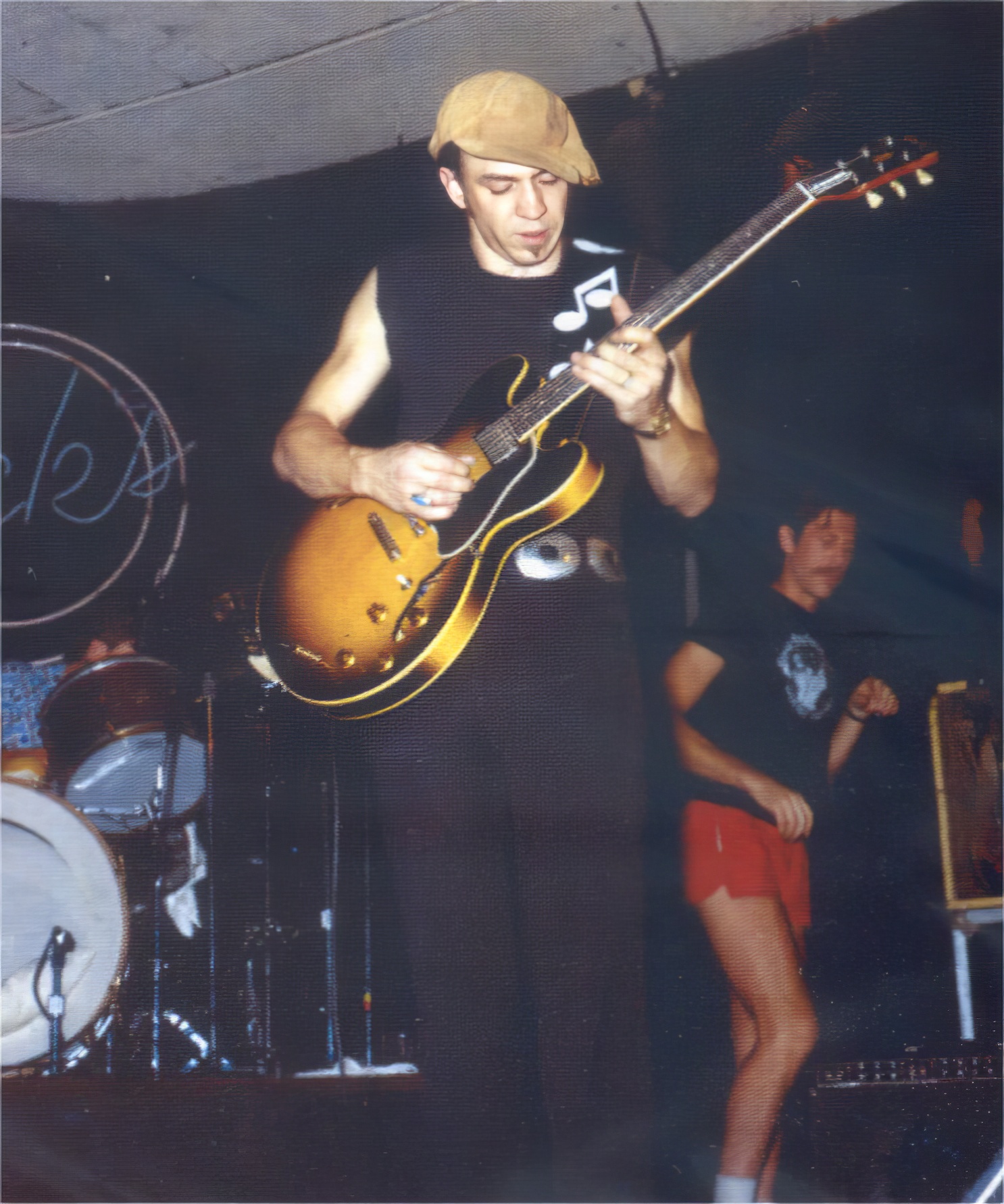

Stevie used this hollow bodied electro-acoustic guitar to record “Stang’s Swang”, from the album "Couldn't Stand the Weather". It is the rarer twin pickup version and has a mother of pearl block fingerboard inlay.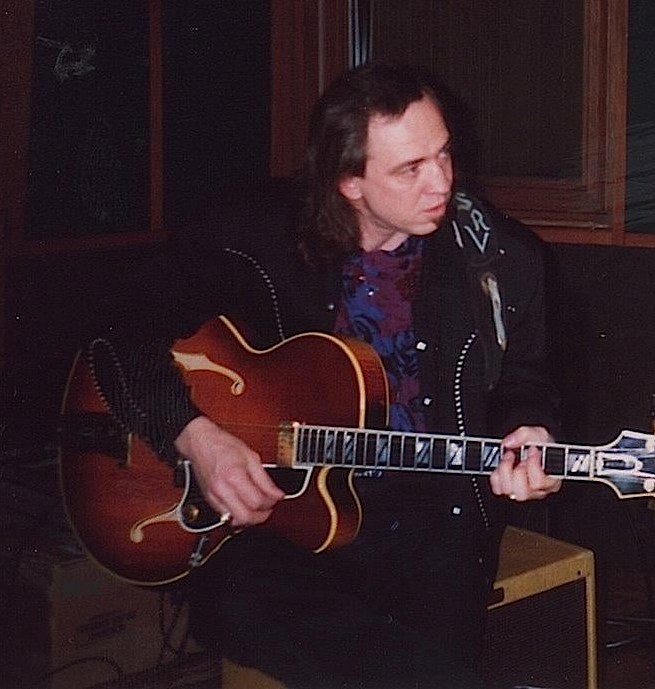
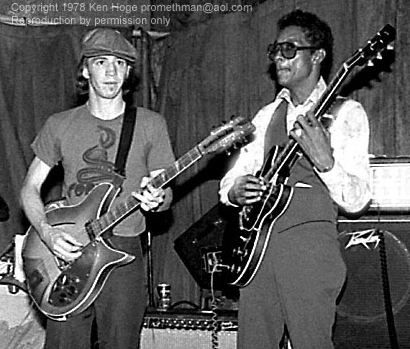
Stevie was seen playing this guitar around 1977/78, whilst in Triple Threat Revue and also while gigging with Hubert Sumlin, and it was supposedly one of his first guitars.
During one of the gigs – which happened to be on Stevie’s birthday, Hubert Sumlin showed up with no guitar after a cabbie drove of with his guitar and amp. Stevie decided to give the Rickenbacker and a Westberry amp to Hubert as a kind of reverse birthday present, though it was stolen soon thereafter.
Amazingly, when Stevie found out the guitar had been stolen from Sumlin, he set out to find it and ended up recovering it. Once he got it back, he personally walked into Antone’s in Austin and returned it to Sumlin before his gig that same night. No one can say that Stevie wasn’t a good friend.
* (info provided by Stevie’s guitar tech Greg Sisk)
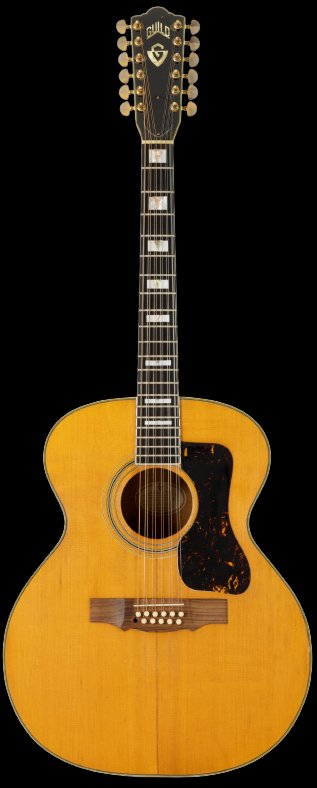
Stevie used this guitar on MTV Unplugged. This guitar was hired from Studio Instrument Rentals in New York City.
Guild produced the F412 model in the 1960s as a custom order-only, and it appears around 20 or so were produced during this time frame. These early models have some unique characteristics that differ from the later production version. One of most apparent differences is the tuners extend much higher on the headstock (above the Guild logo), and they are full size Grover tuners.
Other subtle differences include the "through" saddle as opposed to the later "drop-in" saddle and the older "G-shield" logo on the label.
This guitar was displayed at The Hard Rock Cafe in Dallas until its closing in 2019. In April 2023 Heritage Auctions advertised the F-412 guitar for sale.
The image below shows Stevie playing a different F-412 during his acoustic set and the Cowboys for Indians Benefit gig on 14th October 1985. It is thought that this guitar was loaned to him by his friend and personal assistant Timothy Duckworth. Timothy recalls that Stevie’s hands were so strong that he accidentally cracked the neck.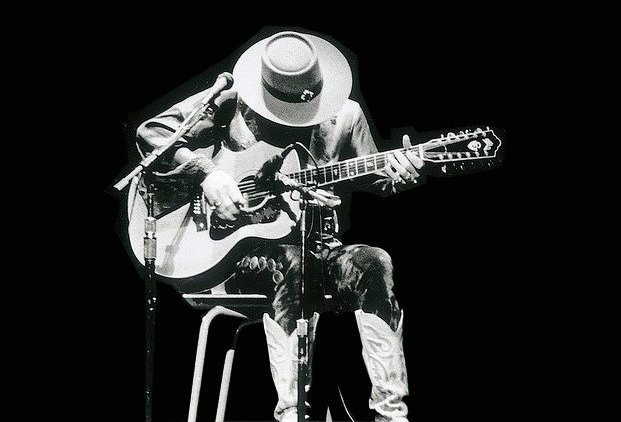

This guitar was given to Stevie by his brother Jimmy around 1966, after Stevie had found it discarded and in bits, in a cupboard in the family home. Stevie put it back together and after Jimmy had given it to him, he added an extra pickup and changed the tone control into a second volume control. The guitar is inscribed "Jimbo" on the back of the body.
The guitar is actually historically significant for two reasons and even without the fact it was Stevie's, it is worth a lot.
In 1951 Fender launched a new guitar, called the Broadcaster. It quickly became apparent that there was already a guitar on the market called a Broadcaster, so Fender had to stop using the name. Unfortunately they'd already made a lot of these guitars, so while they were deciding on a new name, these existing ones were sent to guitar stores, without a logo on the headstock. Fender soon decided on the replacement name of Telecaster and went with that.
The guitars that were shipped without a logo became colloquially known as the "Nocaster" and are collectors' items because they were only available for a few months.
"Jimbo" is one of those guitars without a logo on the headstock and is therefore a "Nocaster"
In 1971, Stevie traded it for a '63 Epiphone Riviera, but after his rise to fame, he publicly begged for the guitar's return, pledging to pay whatever it took to buy it back, but no one came forward. It wasn't until the mid-2000s that the guitar was recognized for what it was, by a man called Loni Specter, a songwriter, photographer, and head of the Los Angeles Amp Show, who happened to see a session musician playing it.
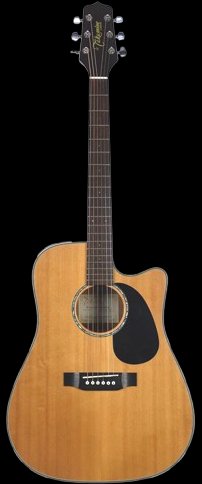
This guitar was used by Stevie on stage at The American Caravan show at The Orpheum Theater on Beale Street, Memphis, Tennessee on 26th August 1986. He used it for the track Oreo Cookie Blues, dueting with Lonnie Mack.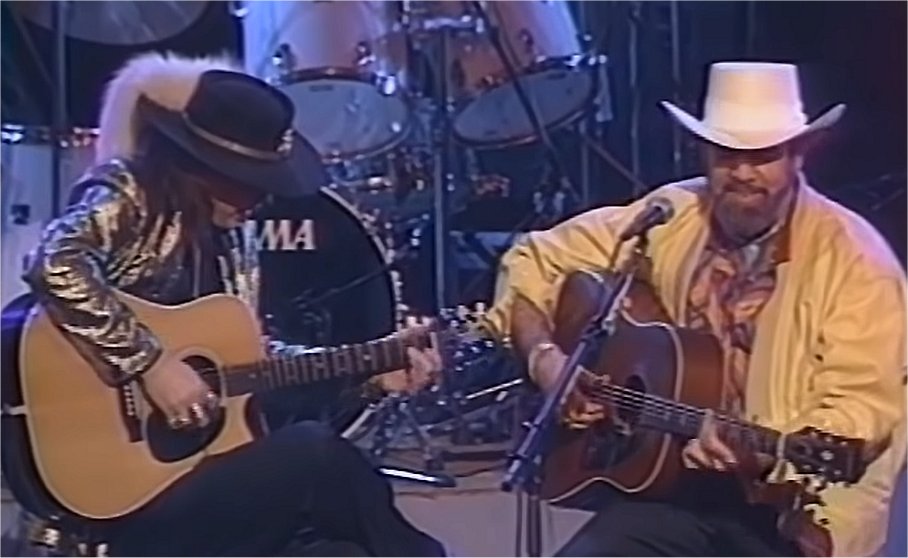
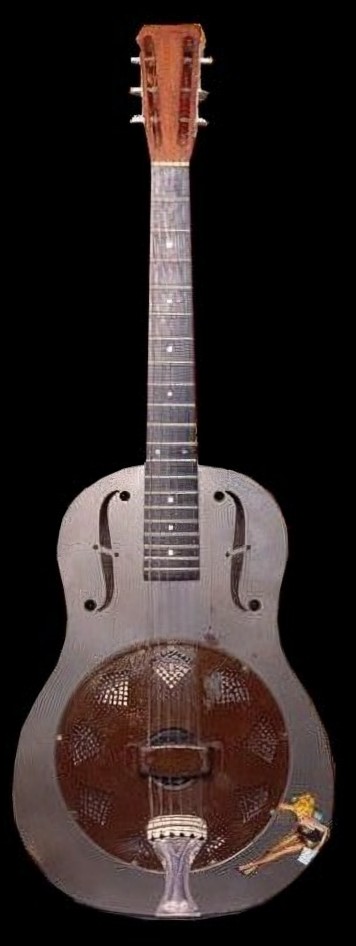
Stevie's 1928 National has been rumored to once being belonged to Blind Boy Fuller. It was given to him by his former roadie, Byron Barr who bought it from Charley’s in 1981.
By most credible accounts, this was one of Stevie's prized posessions. He can be seen holding this guitar on the cover “In Step” album.
The only "known" recording of SRV using this guitar was on "Oreo Cookie Blues" on Lonnie Mack's "Strike Like Lightning" CD.

Stevie was first spotted playing the red and white, semi hollow body 1963 Epiphone Riviera live on 14th January, 1971, in the band Pecos. He was later photographed playing this guitar in other early projects, like Blackbird, the Nightcrawlers (where he opened for ELO, KISS, and ZZ Top), and Krackerjack.
Before Stevie realized his signature fondness for Strats, the Riviera was one of Stevie’s main instruments and remained in his collection long after he stopped playing it regularly. Over the years, it was photographed live in various states with and without the original pickguard. Famously, it popped back up on video over a decade after Stevie first played it in a fiery live version of “Hideaway” with two pickguards — one for the top and one for the bottom.
Left: An early photo of Stevie and during a concert at the USF Sundome in Tampa, FL on 1st August 1984, where he was opening for Huey Lewis and the News.

This guitar was purchased by Stevie in 1986, just before the show at the Harriet Island Riverfest on 11th July 1986. He bought it from Pete's Guitars in St Paul, MN. Fender made 4 prototypes for a guitar that they hoped to put into production. According to one source Fender could not get clearance from Hendrix's Estate, so the project was abandoned. However according to Mark Page, who worked for Fender, 25 of these guitars were made as a special run, for sale by guitar dealers in Texas.
Stevie's prototype was the second of 4 made. He can be seen using it for "Superstition" and "Willie the Wimp"at the 1987 Daytona Beach, FL show.
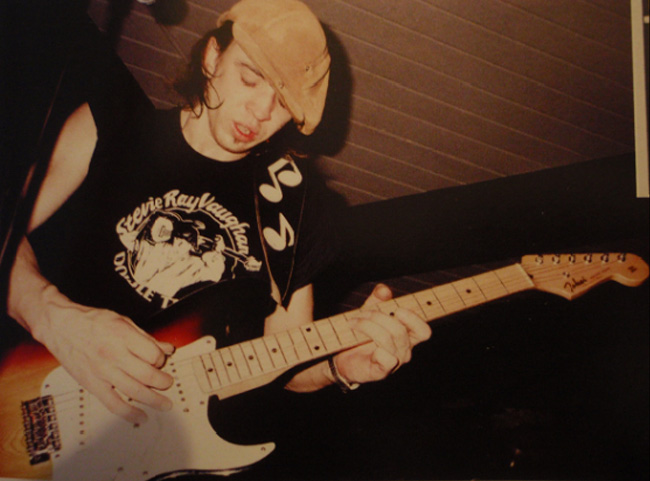
Stevie’s Tokai vintage Strat copies are in many ways the oddest entry in this list. Stevie was rumored to play (and was photographed with) multiple Tokais in the ‘80s. Where this story starts to get interesting is the lack of available information on Stevie’s most famous Tokai: the sunburst, maple neck ‘50s-style Springy Sound model on the cover of Texas Flood.
One of the most bizarre aspects of Stevie’s tie-in with the Springy Sound is that Stevie was never known by those close to him to have purchased it or have seriously played it live or in the studio. A popular guess is that Stevie bought the guitar while on tour, as he would often pick up guitars in the towns that he visited.
Outside of the cover, few — if any — photographs of Stevie playing this guitar live (or in private) are known to exist. With that said, there is a "live" photo of the Texas Flood guitar in Hopkins' book from 1982, so it appears that he did use it live up until a year before Texas Flood was released.
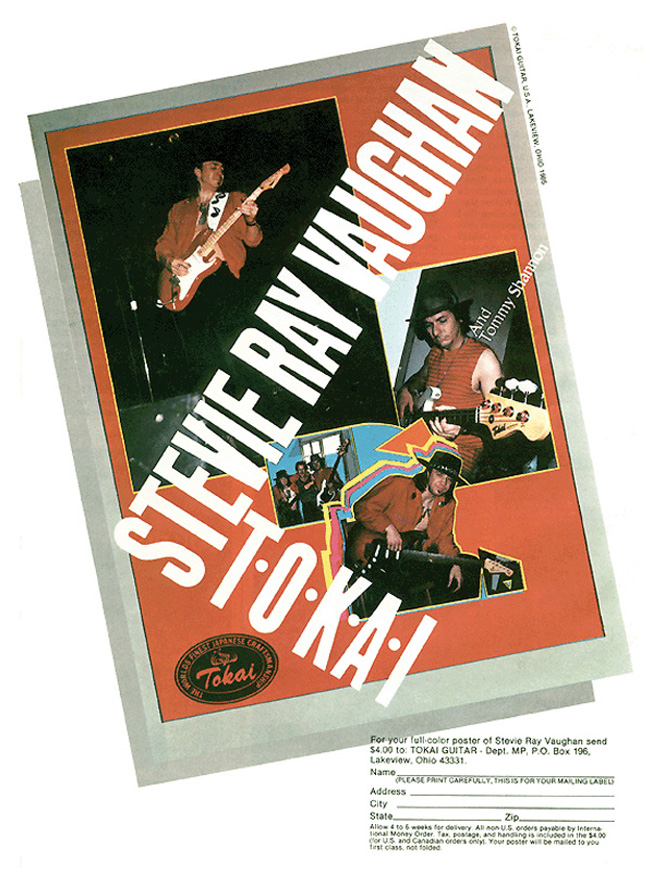
Craig Hopkins posits that an endorsement deal was being explored at the time, and five Tokai guitars plus a of couple basses were negotiated as a goodwill offering toward Stevie signing with the brand. A signed contract for a Tokai endorsement was found that corroborates Hopkins’ guess, but the signature and the information provided on the contract (dated 30th December, 1984) appears to be forged, with his wife Lenora — “Lenny” — as the signed witness.
This potentially falsified contract was likely the basis for the creation of the ’85-’86 Tokai catalog and poster that featured Stevie Ray and Tommy Shannon playing Tokai guitars/basses. Stevie was known to have been infuriated by the marketing. Once, when presented with the poster by a fan, Stevie wrote “I PLAY FENDER” over the Tokai logo.
Another major complication to Hopkins’ explanation that the Texas Flood Tokai was a possible endorsement guitar is that the 1984-’85 timing of this deal puts Tokai in the middle of a headstock change for their American-distributed guitars. In fact, a Stevie-owned Tokai that sold at auction for over $20,000 (with COA and photographic proof) was, in fact, a Tokai AST, which featured an altered, non-vintage, Strat-style headstock.
This guitar that sold also appears to be one of the guitars Stevie is photographed playing in the infamous Tokai poster. All of this together points to the free promotional guitars given to Stevie as being the 1984-introduced ASTs instead of his earlier Springy Sound models.
To make this Stevie-Tokai situation even weirder, Craig Hopkins has stated that Stevie is also playing a Tokai on the cover of Live at Carnegie Hall. The photographic evidence from Chuck Pulin’s photoshoot that night lends credence to his claims, but the decal is neither conclusively a Tokai or Fender based on the available photographs.
* (info provided by reverb.com)

Stevie's Tokai Talbo Blazing Firebird may have been another endorsement guitar, given to him from by the manufacturer. It was built in the 1980's and shows the different path that Tokai started to take, instead of just making copies of American guitars.
The Talbo (Acrynym for Tokai Aluminum Body) has a gold sparkle finish on a chambered aluminum body with a bolt-on maple neck and rosewood fretboard, full 25.5" scale length, and two Tokai humbucking pickups.
It is doubbtful if Stevie ever played this, either live or in the studio, but he had one at his house at Travis Street in Dallas.
Stevie is pictured playing this guitar on the cover of the album "The Sky is Crying".
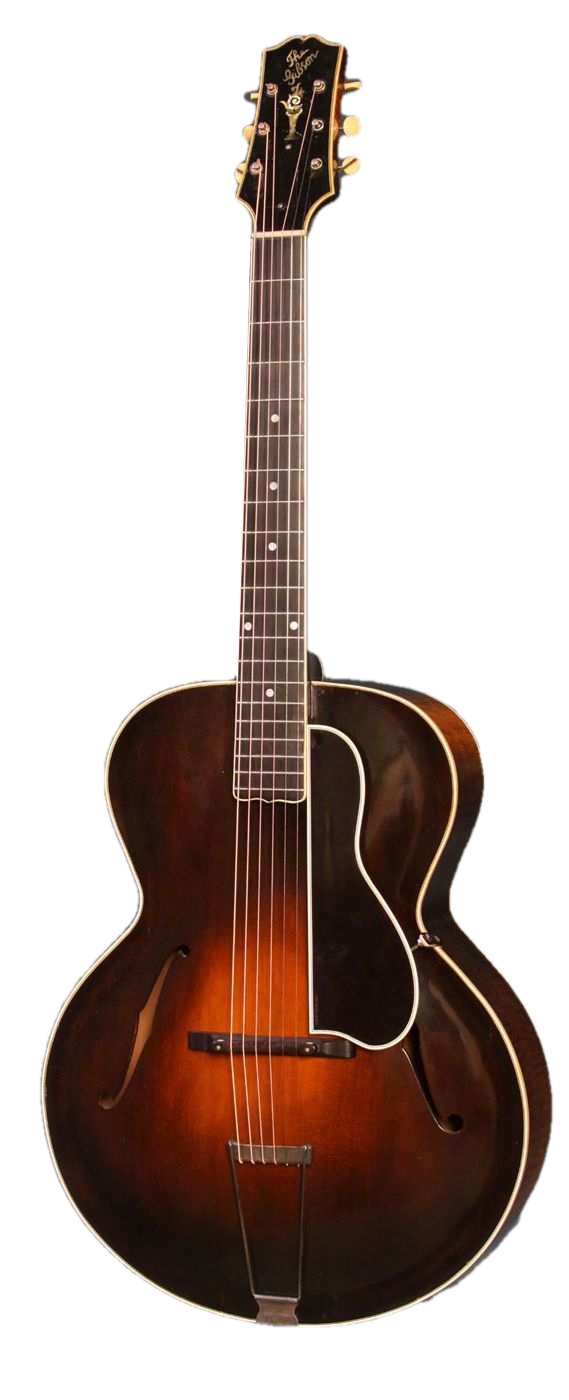
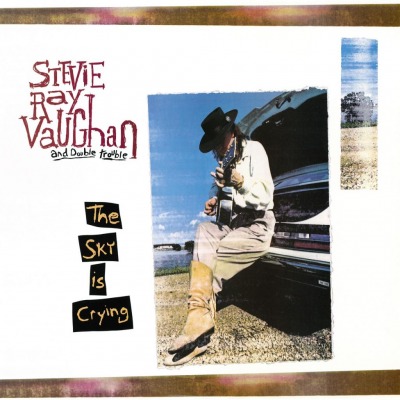
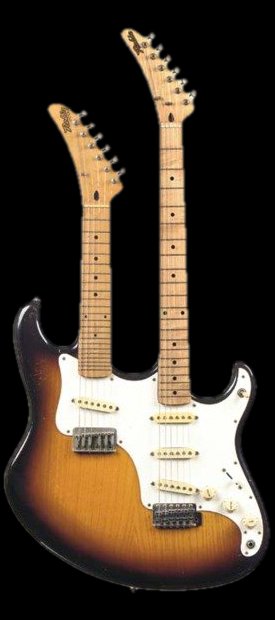
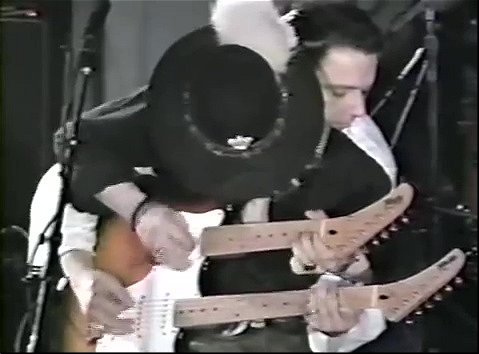
This one-off doubleneck guitar was used for the song "Pipeline" by Stevie Ray Vaughan and his brother Jimmie Vaughan, on board the riverboat SS Presidente, at the 1987 Jazz & Heritage Festival in New Orleans, LA.
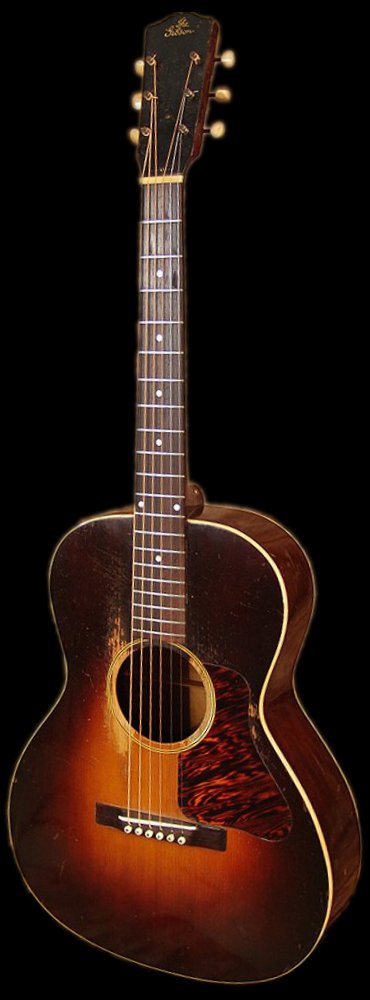
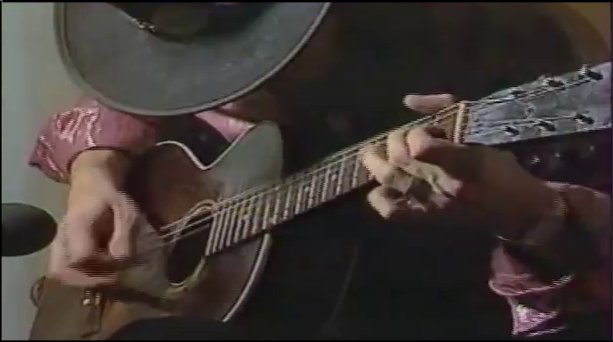
Stevie had this guitar with him for an interview, recorded in Dallas, TX in 1983. It was later broadcast on the French TV programme Houba Houba with Antoine de Caunes. (The video can be found on the SRV Archive YouTube channel)
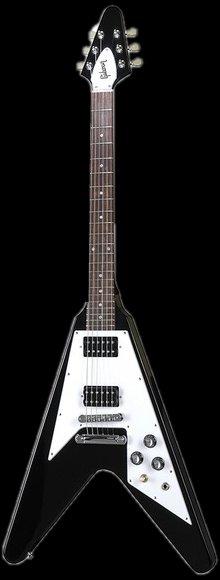
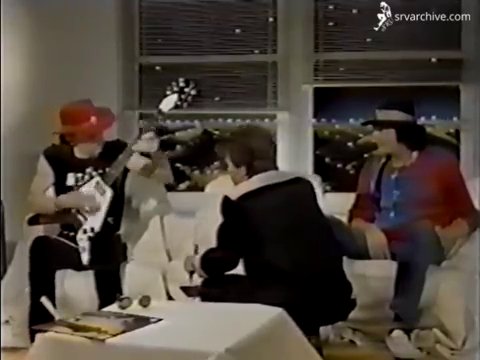
A short impromptu jam session with a Gibson Flying V, accompanied by Chris Layton drumming on the couch for MTV Japan from 1985.
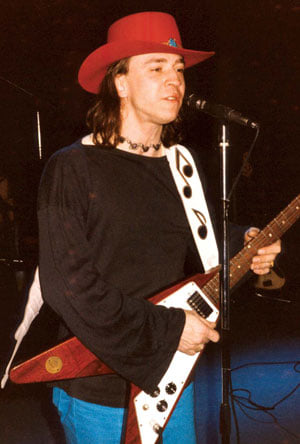
This picture shows Stevie in Japan in 1985, playing the Gibson Flying V Medallion Edition. Only 350 of these guitars were made and it was made famous by Lonnie Mack.
Photograph © Byron Barr.
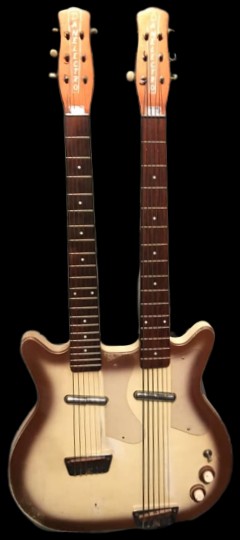
This was an early 1960s model that Stevie had modified. He asked for the 4-string bass neck to be converted to a 6-string bass neck prior to delivery.
He played the guitar at the Pacific Amphitheatre show in Costa Mesa, California on 2nd October 1988, where he was joined on stage with Carlos Santana, and The Fabulous Thunderbirds.
Video here.
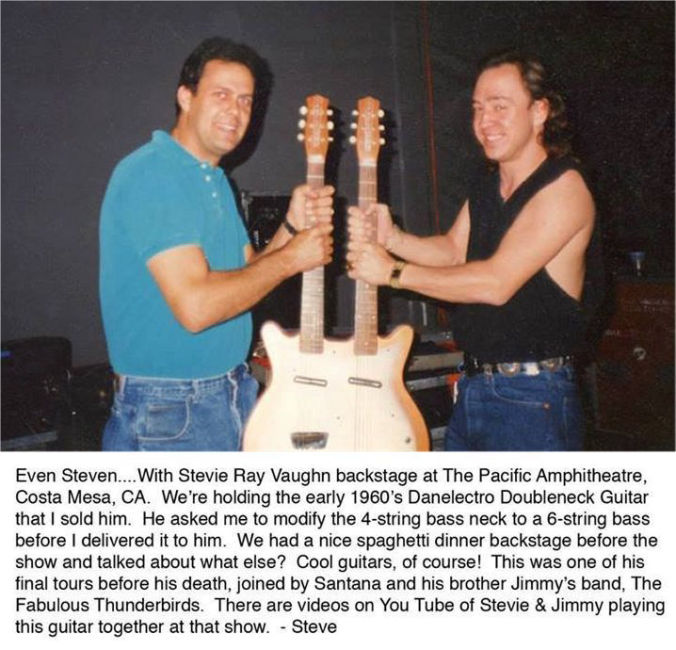
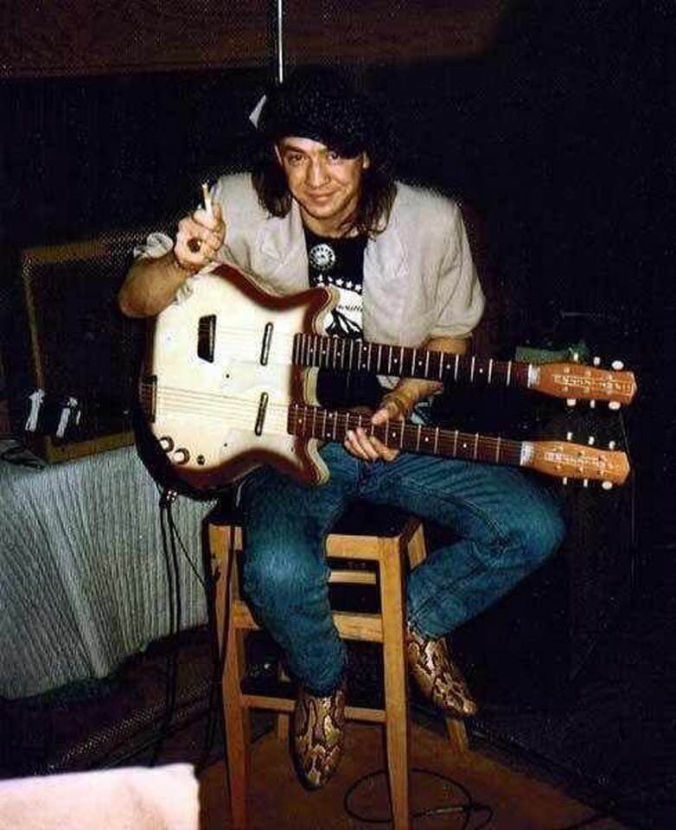
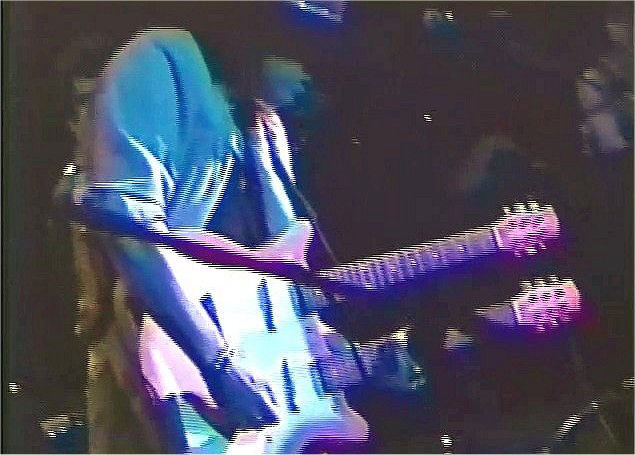
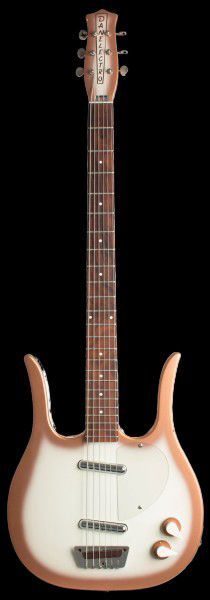
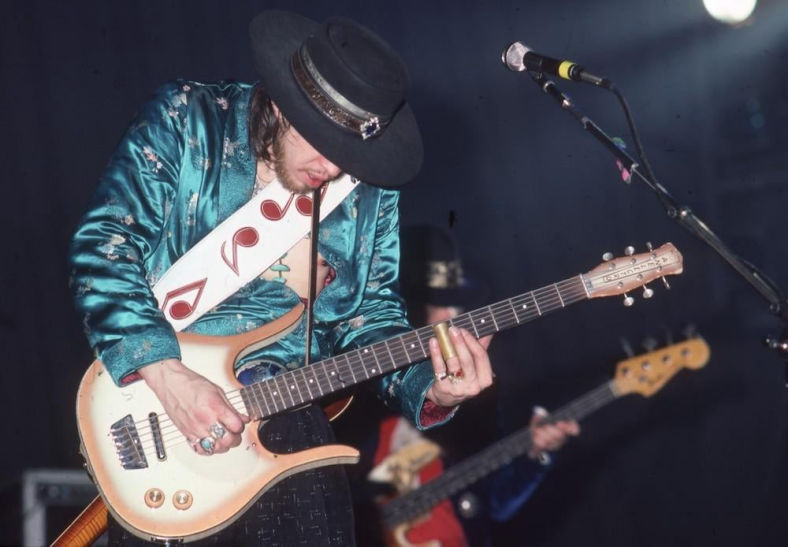
A very rare occurrence with Stevie playing the 6 string bass version of the Danelectro Longhorn. Note that he has "Main" behind his back too!
This photo is from on of the shows at the Royal Oak Music Theatre on 12th, 13th or 14th February 1986. It is thought that the guitar belonged to Jimmie Vaughan at the time. Stevie would borrow it to also play on the second guitar solo of "Couldn't Stand the Weather" .
He also used this guitar whilst playing "Tuff Enough" with the Fabulous Thunderbirds as can be seen here: https://www.youtube.com/watch?v=Z4yxxg5WDkQ
Jimmie would also use this guitar during Stevie's encores where he would come out with Kim Wilson and Preston Hubbard. He can also be heard playing it on "Love Struck Baby" from Live Alive, and seen playing it at the Hordern Pavilion show in Sydney, Australia on 16/17th March 1986 at around 1:03:30 in this video: https://www.youtube.com/watch?v=m7fPLT7CL8k
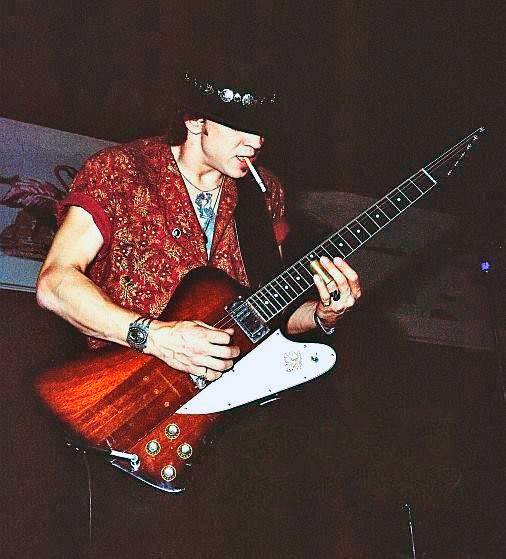
Stevie is pictured here playing his 1964 Firebird at Boston Street Market in Tulsa, Oklahoma, in 1982, at an early Double Trouble show.
The guitar was customised to suit his playing.
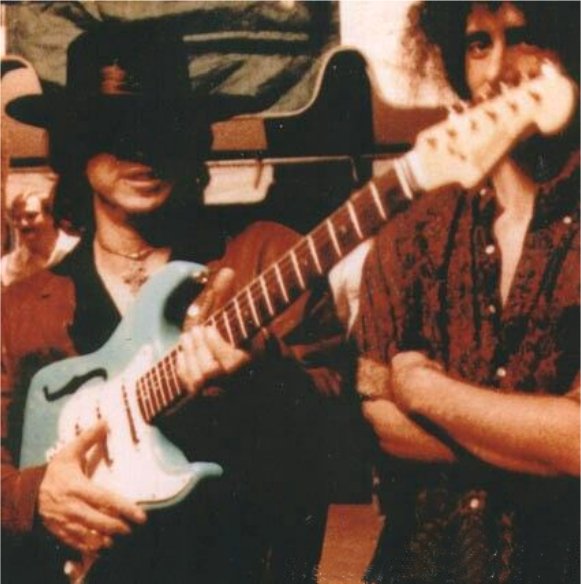
Pictured at Red Rocks in August 1989, Stevie is holding his Groove Master, which was designed and built by Roger Benedict. It featured a semi-hollow spruce body and state-of-the-art electronics.
The name Groove Master was coined by Jackson Browne, (for whom Benedict had also built one) in tribute to its unique sound and playability.
It is not known whether Stevie used this guitar at the Red Rocks show.
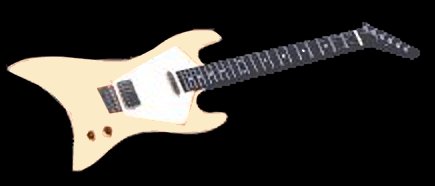
Stevie acquired this guitar around 1983. Kurt Hendrick was a local guitar maker from Houston, who started making guitars in his garage for Texas musicians.
He was inspired greatly by Billy Gibbons and the guitars were well known for their radical look. The Catalyst had a single-coil pickup in the neck position and a humbucker at the bridge.
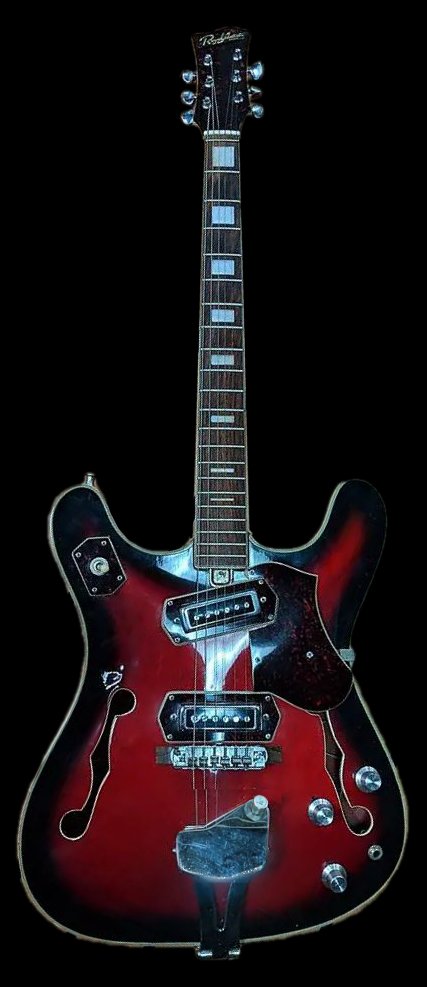
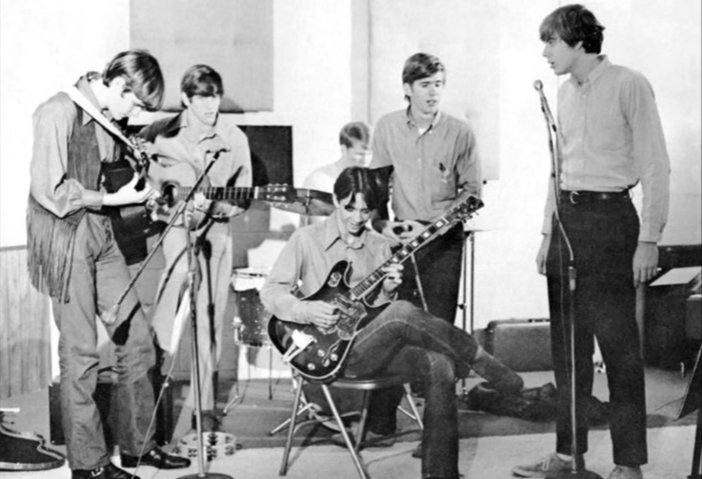
This is the guitar that Stevie played when he was in his High School band “Cast of Thousands”.
He more than likely used it during the recording of the 2 tracks for the album “A New Hi”.
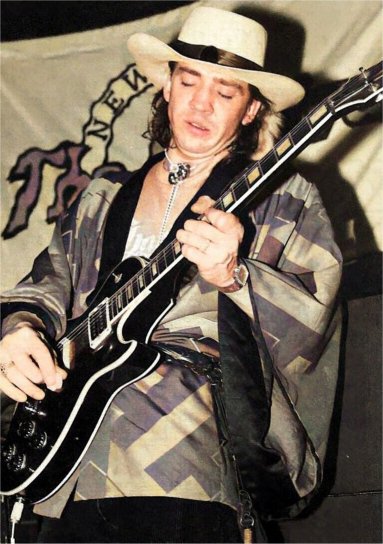
Stevie is pictured on the left using a borrowed Gibson Les Paul, on 10th August 1985 at the Lone Star Cafe in New York City. He was guesting with Robert Gordon, after having already played at Pier 84 earlier that evening.
The photo below shows Stevie on another borrowed Les Paul, this time on 1st March 1988 at a pre Grammy party at the Palladium, New York.
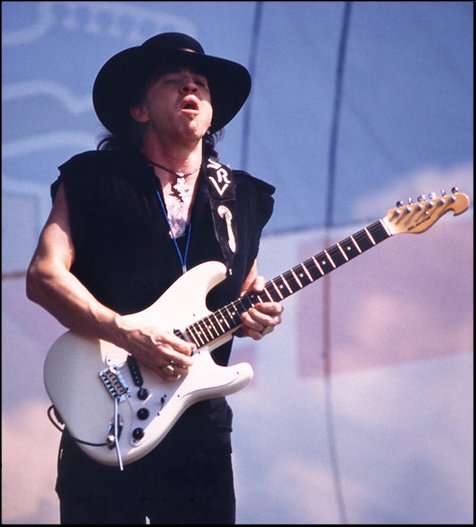
Stevie used this guitar for at least one song at the Miller Lite Party show, at the Cotton Bowl in Dallas on 3rd September 1989. Very similar to a standard strat except for the pickups and the "hook-nose" headstock.
The guitar can also be seen in the calendar photo shoot Stevie did with Dallas DJ Jill Savage in October 1989.
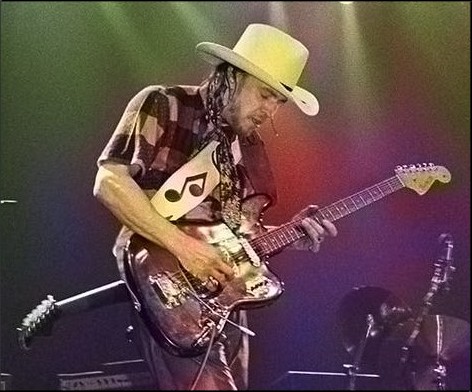
This is a rare picture of Stevie using a Fender Bass VI, at the Sam Houston Coliseum on 1st February 1986. He would this guitar for the second guitar solo on CSTW, usually with a slide. He only did that in late 85/early 86. Stevie can be seen picking up this guitar at around 39 minutes in this video: https://www.youtube.com/watch?v=m7fPLT7CL8k
First released in 1961, it followed the concept of the Danelectro six-string bass released in 1956, having six strings tuned E to E, an octave below a standard tuned guitar. It was designed to bridge the gap between the playability of a guitar and the low-end power of a bass.
The VI had an offset body similar to that of the Fender Jazz. However it differed in having six strings, a shorter scale, thinner strings and a mechanical vibrato arm.
The Bass VI never really caught on and was discontinued in 1975.
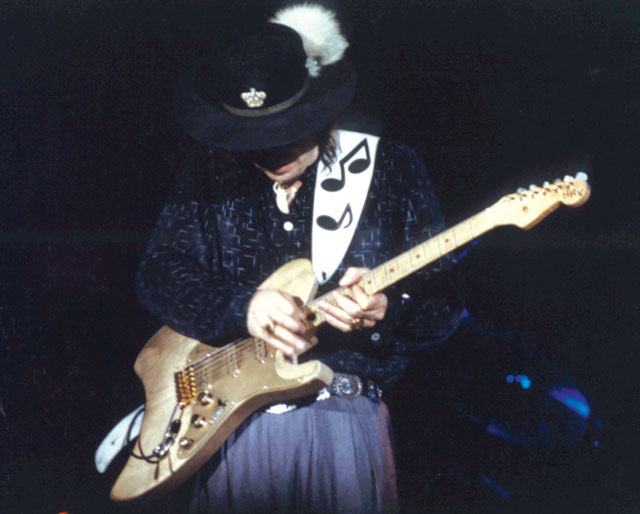
This guitar was designed by Stevie himself. Stevie sketched out the shape and prototype design of the guitar in 1982 and consulted with experts on the technical limitations he'd have to overcome to bring it to life.
By 1984 Stevie had expressed his interest to design and build a custom guitar, with the possibility to go on and mass produce it. He was assisted by Swedish guitarist Gordon van Ekstrom.
Various options were discussed, including having the pickups in the shape of Stevie’s initials. Seymour Duncan were approached with this idea, but they said it would not work. The unfinished guitar was used on one song at the Metro Center, Halifax, NS in Canada in April 1988 and then not used again.
Stevie was photographed with multiple takes on a single cutaway prototype body in 1984, as well as the double cutaway version in the mid-to-late-’80s.
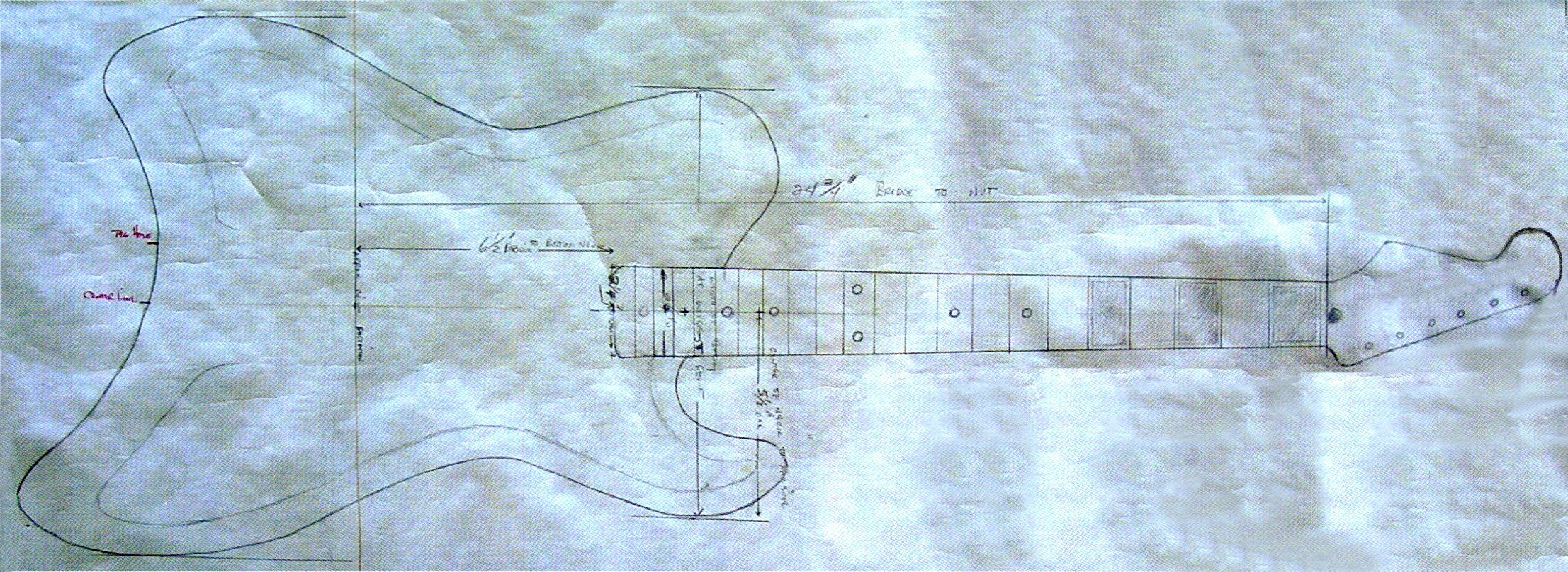
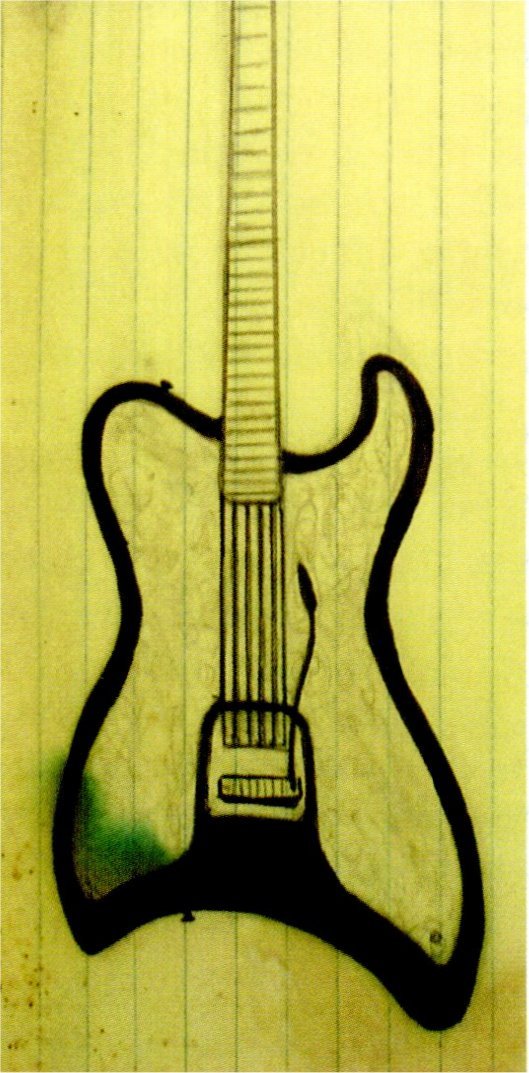
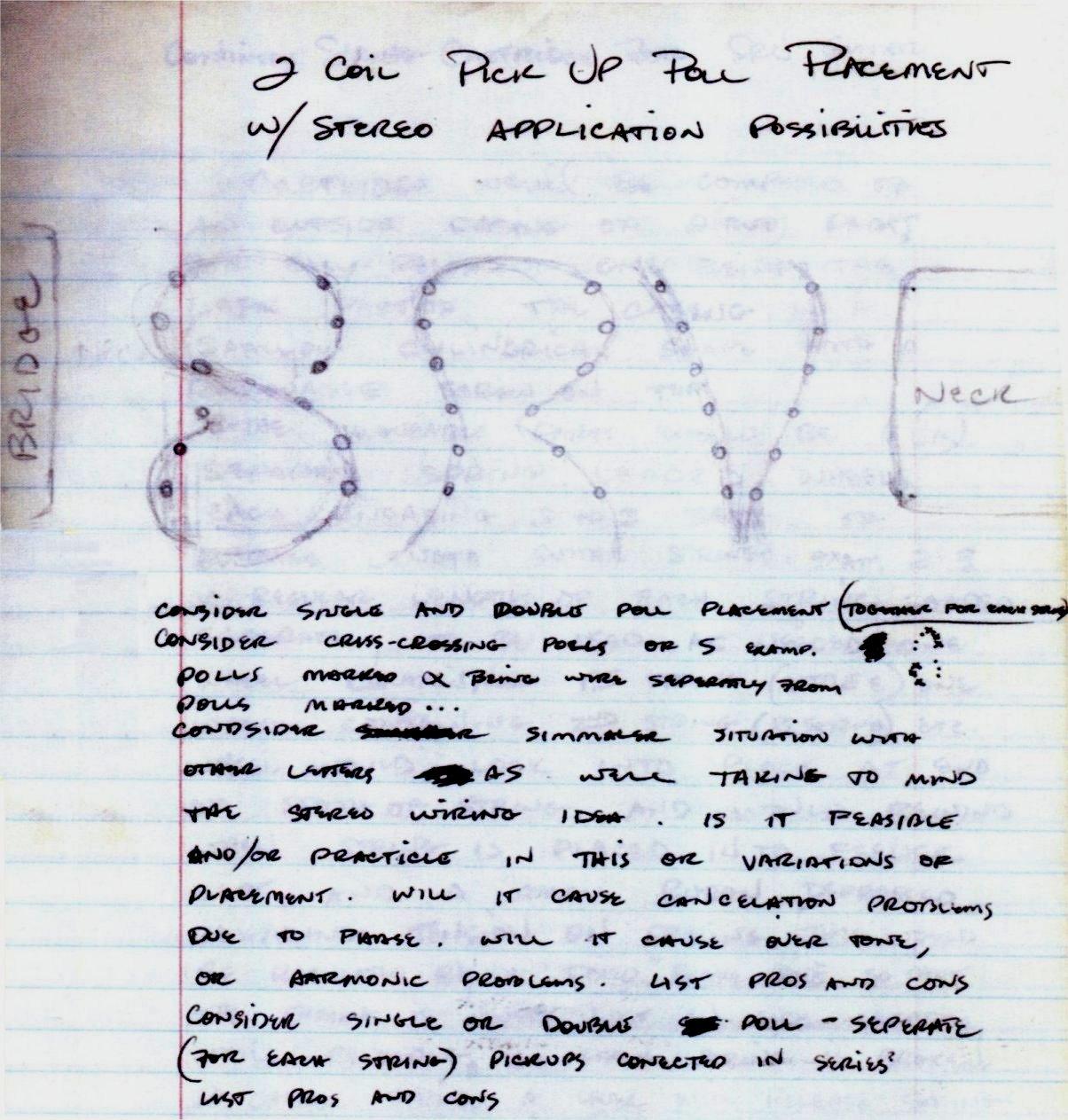
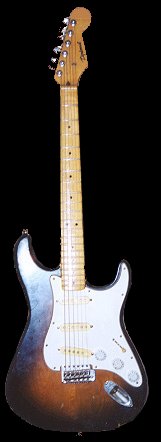
Diplomat guitars were Japanese made Stratocaster copies. They were imported into New Zealand to get round the scarcity of genuine Fender guitars in the country.
Stevie bought this guitar for his girlfriend Janna to learn to play on in 1986.
1962 (sic) Stratocaster (#1)
1962 Stratocaster (Red)
1962 Stratocaster (Cream)
1972 Strat (Cream) (Prototype Left-Handed Neck)
1961 Stratocaster (Cream)
1984 Charley's Stratocaster type
1956 Stratocaster (Sunburst)
1984 Hamiltone
National Duolian
Strat type (Clear Plexiglass)
(1961?) Gibson E5-335 (Sunburst)
Gibson Flying V (Ltd Edition)
Gibson SG Custom (White)
Gibson CFIOO Cutaway Acoustic
Gibson F-Hole Electric (Sunburst)
Epiphone 6-String Bass
Mitre Guitar (Python)
Tokai Strat Copy
Blacknife Prototype Graphite Guitar
G&L Invader (Black)
G&L Skyhawk (Red)
Richelieu SRV Model (Black)
Peavey Impact l (Red)
Peavey Impact 2 (Black)
Silvertone (Black)
Kay Semi-Hollow Body
Lazr Mini
Maccaferri Plastic Guitar
Airline Semi-Hollow (Blond Maple)
$3000
$2500
$1500
$2000
$2500
$1000
$2000
$1400
$1500
$500
$1500
$2000
$1300
$1500
$800
$400
$400
$300
$500
$500
$500
$800
$500
$600
$200
$300
$400
$300
$300